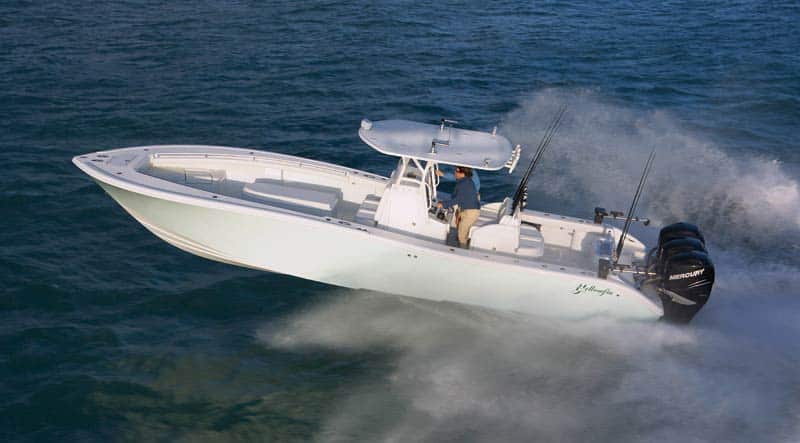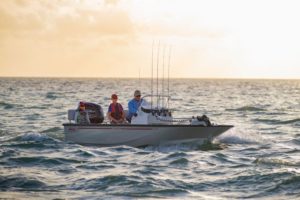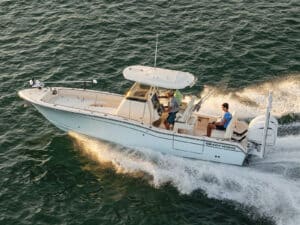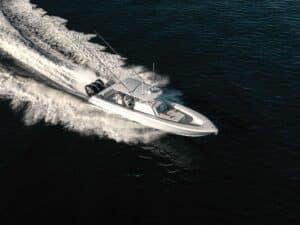
boat hull shapes
Boats, like cars, often feature a shape that defines them, that makes their purpose expressly obvious. The shapes of a Maserati car and a Yellowfin boat, for instance, say — what else? — speed.
But boat hull designs also carry subtler messages that help boat buyers home in on just the right choice for their fishing style. The width of the chines, the deadrise angle, and the presence of a pad and steps — among other facets — change the comfort and speed of the craft.
What’s in a Shape?
“The general philosophy for any planing boat (the category for most trailerable fishing boats) is that the shape of the hull should match its weight,” says Darron Roop, a naval architect and yacht designer based in Virginia Beach, Virginia (shorebreakmarine.com). “You want the hull to ride at the right attitude so it handles and tracks better. The second aspect is: Where’s your impact zone? Where’s the boat hitting the water?”
Factors besides hull shape obviously enter the above equations, and Roop is quick to point out that no single design element determines the overall package. In addition, different boats are made for different purposes and different buyers in different locations. But — in general — when tinkering with the running surface of a monohull boat, Roop and others often play with the deadrise angle.
In the fishing world, monohulls comprise flat-bottom skiffs, moderate-V and deep-V boats. Multihull boats have also gained a foothold among anglers because of their deck space and stability at rest. In fact, some designers say power-catamaran hulls are underutilized as fishing boats. The most common error made in building cat hulls, they say, is making the sponsons too wide.
Flat hulls might be easiest to build and have more initial stability per weight, according to the book The Nature of Boats by New York naval architect Dave Gerr (www.gerrmarine.com), but they also generally flex more and handle waves rather harshly.
As designers increase the angle of the hull to form a V, they see the vessel’s rough-water ride improve. A standard moderate-V hull carries a deadrise angle of 15 to 20 degrees at the transom. Deep-V’s generally start at 21 degrees and go up to about 26.
“At high speed in rough water, deep-V’s pound less than most, and are more stable,” Gerr says. “But as you slow down, they start to flop back and forth more; they’re not as comfortable at slow speed or at anchor.”
A final category is the variable-deadrise hull, wherein the lowest or deepest section of the hull forms a steep angle, and each subsequent section between the longitudinal strakes (the ridges that run fore and aft) angles less and less. The theory is that such a graduated deadrise puts the deepest angle at the keel so that it lessens impact. Flattening the deadrise as it approaches the chines (where the hull bottom meets the sides) should then offer some of the stability benefits of a flatter hull.
Tricks of the Trade
With some moderate- and deep-V vessels, the deadrise remains more or less constant from amidships to the transom, though it narrows at the bow. But in many cases, designers create what’s called a modified-V or “warped plane” hull — wherein the deadrise decreases from a high of perhaps 22 degrees amidships to 15 degrees at the transom. A flatter transom allows the boat to travel faster than a deeper hull with the same horsepower. Stated differently: The more deadrise you have, the more power you need to get the same speed.
Lou Codega, a Virginia-based naval architect (www.loucodegana.com) who has designed vessels of all sizes — including current Regulator hulls — used a modified deep-V for those popular fishing boats. At the transom, Regulators measure 24 degrees; the deadrise increases almost all the way forward to about 48 or 49 degrees.
“Where you really feel the most impact is at the place where the water hits the boat. That can be anywhere from the bow to 50 percent or 70 percent back toward the stern. That’s the deadrise that the water sees,” he says. “And that’s really where the magic happens. There’s no formula or textbook that says, ‘At this specific point on the hull, you should have 36 degrees deadrise.’ The difference between a good- and bad-riding boat is how you’ve gone from whatever number you have at the transom to the number at the bow.”
Regulators, like many fishing vessels, feature a single chine on each side of the boat. The chine usually forms a sharp angle — as sharp as possible with fiberglass. Inward from the chine is a flat surface — the chine flat — that might measure two to six inches based on the size of the boat.
Chines and the adjacent flat surfaces redirect spray to the side and create lift, Codega says. Beneath the hull, most fishing boats also have strakes that similarly knock down spray but also reduce friction.
“Strakes strip the sheet of water off the hull of the boat,” Codega says. “That reduces resistance and changes trim a little.”
The Speed Creed
Some companies take deep-V’s to another level, specifically those builders that make offshore-tournament center-consoles. Wylie Nagler, owner of Yellowfin Yachts (www.yellowfinyachts.com) in Sarasota, Florida, entered the tournament mix with a boat-racing background. His Yellowfins feature state-of-the-art-design technology, including a stepped running surface, a flattened pad near the transom and slightly wider, downturned chines.
Yellowfin also takes great care in considering fishing needs. “The old theory was the skinnier the boat, the faster the boat,” Nagler says. “Twenty years ago, people started putting center‑consoles on go-fast boats, and they found that the boat does go fast, but it doesn’t have any room. You need to have some room to have a well-thought-out fishing boat. There’s a ratio of length to beam that doesn’t hamper performance.”
Builders also play with the proportion between chine width (wider chines increase stability at rest), the pad design, and the step size and angle. The pad helps create better stability at speed. “If you look at the back of a conventional-V boat, it will be curved at the bottom or come to a knife edge,” Nagler says. “We have created something that’s 12 to 14 inches wide; it’s a V pad, not a flat pad. It means less deadrise in the keel, but there’s still a little to keep the boat from slapping.”
Steps introduce air, which reduces friction for better efficiency and speed — 25 percent to 30 percent better fuel economy and 15 percent increased speed, Nagler says. But some step designs work and some don’t, he explains, referring to the location of the steps and their angle. “When you’re running fast in a following sea, they can have a tendency to bow steer,” he says. “If a stepped hull is designed correctly, you cannot tell any difference in the handling of the boat from a conventional V bottom.”
Nagler says the steps in a Yellowfin hull are fairly shallow. In addition, rather than running perfectly straight strakes, he staggers them on the steps, which he says creates stability.
Lower and Lighter
Most bay boats and flats skiffs feature deadrise angles in the teens; 15 degrees is a fairly typical starting point. A slight angle helps skiffs run a little better in open sounds and in locations such as the mid-Atlantic, where inshore anglers venture outside the inlets.
“If I were selling bay boats from Cape Hatteras to New England only, I might have more deadrise and a sharper entry,” says Roop, who has designed Maverick and Pathfinder boats, among others. “If not, then I’d dial it down a little. A boat is not necessarily going to run worse if it has less transom deadrise. You wouldn’t want to use that one characteristic to drive your opinion.”
Deep-V hulls not aimed for the go-fast crowd often help prove this point. Roop says that in designing Cobia boats — targeting a broader demographic — he dialed down the deadrise angle to 21 degrees, making them flatter boats at the transom to reduce rolling.
“There’s still plenty of deadrise here, so you can run the boat hard and be very comfortable with it,” he says. “The width [of the boat] and the deadrise combine to make it run at the right attitude. That’s why I tell people to go run a boat to find out how it rides. If someone has done a good job designing it, they’ll be more comfortable.”
Outboard boats should run flatter, though in a following sea, they shouldn’t run too flat. Generally, Roop says, the flatter the boat runs, the less vertical acceleration it generates and the more comfortable it will be. However, Cobia boats were not intentionally built to run from wave top to wave top — as some go-fast hulls — but rather they employ a fine entry to slice through the waves for a soft ride.
The bottom line is that many factors work together to make a boat run properly. Don’t assume a specific deadrise number automatically pigeonholes a boat’s performance, Roop says. “My designs are all about finding the right running attitude,” he says. “The hull, the speed, the weight — all things have to dial in to get the attitude.”








